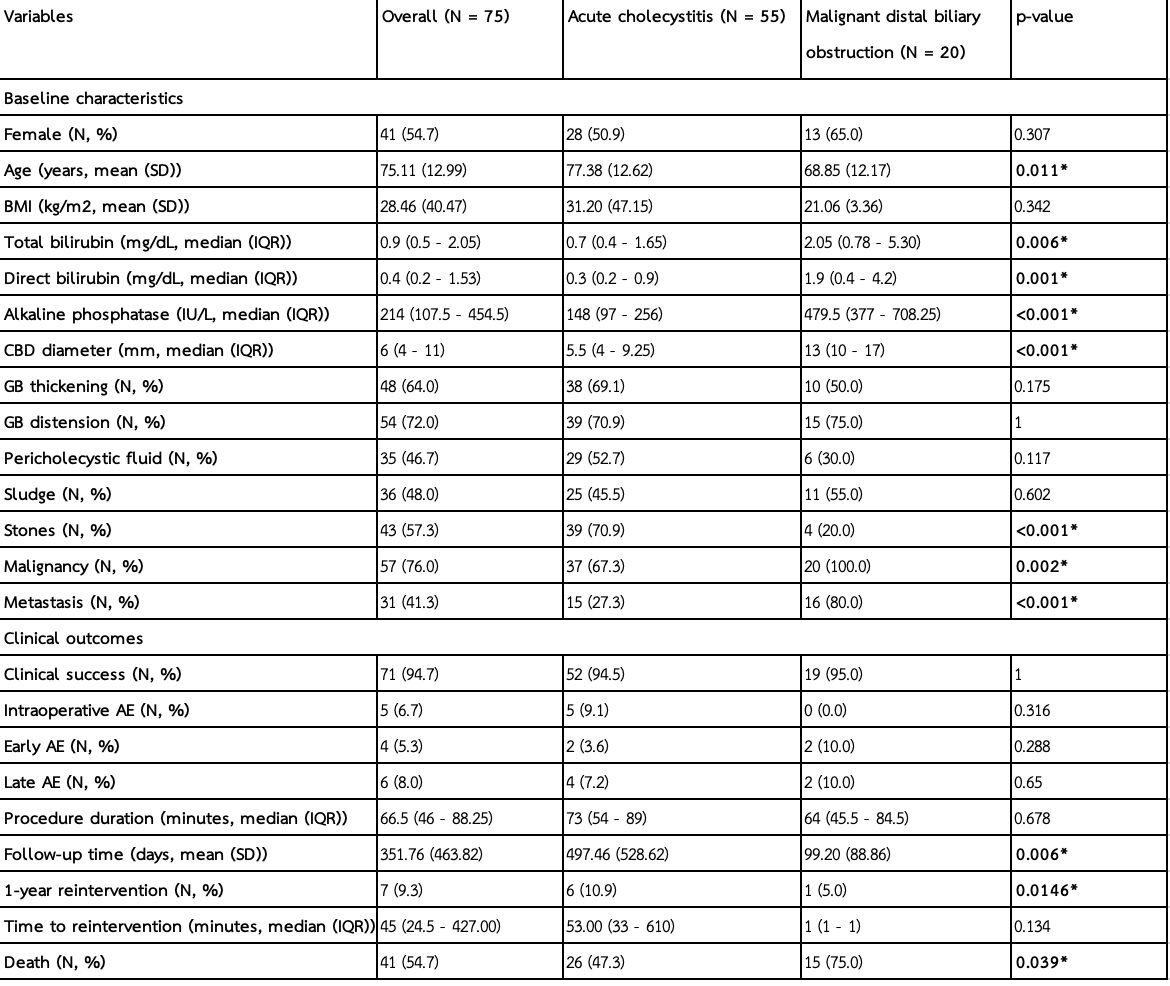Sunday Poster Session
Category: Interventional Endoscopy
P1397 - Long-Term Outcomes After Endoscopic Ultrasound-Guided Gallbladder Drainage for Acute Cholecystitis and Malignant Biliary Obstruction: A Multicenter Study
Sunday, October 26, 2025
3:30 PM - 7:00 PM PDT
Location: Exhibit Hall

Noppachai Siranart, MD
Brigham and Women's Hospital, Harvard Medical School
Boston, MA
Presenting Author(s)
Noppachai Siranart, MD1, Steven Steinway, MD2
1Brigham and Women's Hospital, Harvard Medical School, Boston, MA; 2Brigham and Women's Hospital, Boston, MA
Introduction: Endoscopic ultrasound-guided gallbladder drainage (EUS-GB) has emerged as a minimally invasive alternative for patients requiring decompression of the gallbladder, particularly in cases of acute cholecystitis or malignant distal biliary obstruction (MDBO) where traditional treatments may be high-risk or not possible. While short-term outcomes of EUS-GB are well documented, data on its long-term efficacy and safety remain limited. Additionally, it is unclear whether outcomes differ by indication, prompting a subgroup analysis comparing acute cholecystitis and MDBO patients.
Methods: We conducted a retrospective analysis of patients who underwent EUS-GB at two US academic hospitals from 2015-2024. Primary outcomes included technical and clinical success, reintervention rate, and adverse events (AEs). Long-term follow-up data were reviewed to assess outcome durability. A subgroup analysis compared these outcomes between patients treated for acute cholecystitis and those treated for MDBO.
Results: 77 patients were included, with 56 (72.7%) having acute cholecystitis and 21 (27.2%) with MDBO. The mean follow-up was 351 days. Technical and clinical success were 97.4% and 94.7%, respectively, with comparable rates between groups. Early and late AEs occurred in 5.3% and 8.0% of patients overall and were similar between acute cholecystitis and MDBO with early AEs (3.6% vs 10%, p=0.288) and late AEs (16.4% vs 15%, p=1). One-year reintervention rate was 9.3%, significantly higher in acute cholecystitis than MDBO (10.9% vs. 5%, p = 0.014). The median time to reintervention for cholecystitis patients was 53 days.
Discussion: EUS-GB has high technical and clinical success with low AE rate. At a median follow-up of about one-year the overall reintervention rate is low for EUS-GB and is significantly higher in the cholecystitis subgroup compared to MDBO.

Figure: Figure 1. Baseline characteristics of included patients and outcomes
Disclosures:
Noppachai Siranart indicated no relevant financial relationships.
Steven Steinway indicated no relevant financial relationships.
Noppachai Siranart, MD1, Steven Steinway, MD2. P1397 - Long-Term Outcomes After Endoscopic Ultrasound-Guided Gallbladder Drainage for Acute Cholecystitis and Malignant Biliary Obstruction: A Multicenter Study, ACG 2025 Annual Scientific Meeting Abstracts. Phoenix, AZ: American College of Gastroenterology.
1Brigham and Women's Hospital, Harvard Medical School, Boston, MA; 2Brigham and Women's Hospital, Boston, MA
Introduction: Endoscopic ultrasound-guided gallbladder drainage (EUS-GB) has emerged as a minimally invasive alternative for patients requiring decompression of the gallbladder, particularly in cases of acute cholecystitis or malignant distal biliary obstruction (MDBO) where traditional treatments may be high-risk or not possible. While short-term outcomes of EUS-GB are well documented, data on its long-term efficacy and safety remain limited. Additionally, it is unclear whether outcomes differ by indication, prompting a subgroup analysis comparing acute cholecystitis and MDBO patients.
Methods: We conducted a retrospective analysis of patients who underwent EUS-GB at two US academic hospitals from 2015-2024. Primary outcomes included technical and clinical success, reintervention rate, and adverse events (AEs). Long-term follow-up data were reviewed to assess outcome durability. A subgroup analysis compared these outcomes between patients treated for acute cholecystitis and those treated for MDBO.
Results: 77 patients were included, with 56 (72.7%) having acute cholecystitis and 21 (27.2%) with MDBO. The mean follow-up was 351 days. Technical and clinical success were 97.4% and 94.7%, respectively, with comparable rates between groups. Early and late AEs occurred in 5.3% and 8.0% of patients overall and were similar between acute cholecystitis and MDBO with early AEs (3.6% vs 10%, p=0.288) and late AEs (16.4% vs 15%, p=1). One-year reintervention rate was 9.3%, significantly higher in acute cholecystitis than MDBO (10.9% vs. 5%, p = 0.014). The median time to reintervention for cholecystitis patients was 53 days.
Discussion: EUS-GB has high technical and clinical success with low AE rate. At a median follow-up of about one-year the overall reintervention rate is low for EUS-GB and is significantly higher in the cholecystitis subgroup compared to MDBO.

Figure: Figure 1. Baseline characteristics of included patients and outcomes
Disclosures:
Noppachai Siranart indicated no relevant financial relationships.
Steven Steinway indicated no relevant financial relationships.
Noppachai Siranart, MD1, Steven Steinway, MD2. P1397 - Long-Term Outcomes After Endoscopic Ultrasound-Guided Gallbladder Drainage for Acute Cholecystitis and Malignant Biliary Obstruction: A Multicenter Study, ACG 2025 Annual Scientific Meeting Abstracts. Phoenix, AZ: American College of Gastroenterology.
